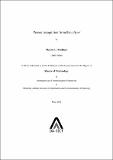Please use this identifier to cite or link to this item:
http://drsr.daiict.ac.in//handle/123456789/338Full metadata record
| DC Field | Value | Language |
|---|---|---|
| dc.contributor.advisor | Patil, Hemant A. | |
| dc.contributor.author | Madhavi, Maulik C. | |
| dc.date.accessioned | 2017-06-10T14:38:58Z | |
| dc.date.available | 2017-06-10T14:38:58Z | |
| dc.date.issued | 2011 | |
| dc.identifier.citation | Madhavi, Maulik C. (2011). Person recognition from their hum. Dhirubhai Ambani Institute of Information and Communication Technology, xiv, 99 p. (Acc.No: T00301) | |
| dc.identifier.uri | http://drsr.daiict.ac.in/handle/123456789/338 | |
| dc.description.abstract | In this thesis, design of person recognition system based on person's hum is presented. As hum is nasalized sound and LP (Linear Predication) model does not characterize nasal sounds sufficiently, our approach in this work is based on using Mel filterbank-based cepstral features for person recognition task. The first task was consisted of data collection and corpus design procedure for humming. For this purpose, humming for old Hindi songs from around 170 subjects are used. Then feature extraction schemes were developed. Mel filterbank follows the human perception for hearing, so MFCC was used as state-of- the-art feature set. Then some modifications in filterbank structure were done in order to compute Gaussian Mel scalebased MFCC (GMFCC) and Inverse Mel scale-based MFCC (IMFCC) feature sets. In this thesis mainly two features are explored. First feature set captures the phase information via MFCC utilizing VTEO (Variable length Teager Energy Operator) in time-domain, i.e., MFCC-VTMP and second captures the vocal-source information called as Variable length Teager Energy Operator based MFCC, i.e., VTMFCC. The proposed feature set MFCCVTMP has two characteristics, viz., it captures phase information and other it uses the property of VTEO. VTEO is extension of TEO and it is a nonlinear energy tracking operator. Feature sets like VTMFCC captures the vocal-source information. This information exhibits the excitation mechanism in the speech (hum) production process. It is found to be having complementary nature of information than the vocal tract information. So the score-level fusion based approach of different source and system features improves the person recognition performance. | |
| dc.publisher | Dhirubhai Ambani Institute of Information and Communication Technology | |
| dc.subject | Speech perception | |
| dc.subject | Speech processing systems | |
| dc.subject | Speech recognition | |
| dc.subject | Acoustic pattern recognition | |
| dc.subject | MFCC | |
| dc.subject | Hidden Markov Model | |
| dc.subject | Speaker recognition | |
| dc.subject | Text independent | |
| dc.subject | Vector quantization | |
| dc.subject | Gaussian mixture model | |
| dc.subject | Pattern recognition systems | |
| dc.subject | Biometric identification | |
| dc.classification.ddc | 006.45 MAD | |
| dc.title | Person recognition from their hum | |
| dc.type | Dissertation | |
| dc.degree | M. Tech | |
| dc.student.id | 200911036 | |
| dc.accession.number | T00301 | |
| Appears in Collections: | M Tech Dissertations | |
Files in This Item:
| File | Description | Size | Format | |
|---|---|---|---|---|
| 200911036.pdf Restricted Access | 3.13 MB | Adobe PDF |  View/Open Request a copy |
Items in DSpace are protected by copyright, with all rights reserved, unless otherwise indicated.
